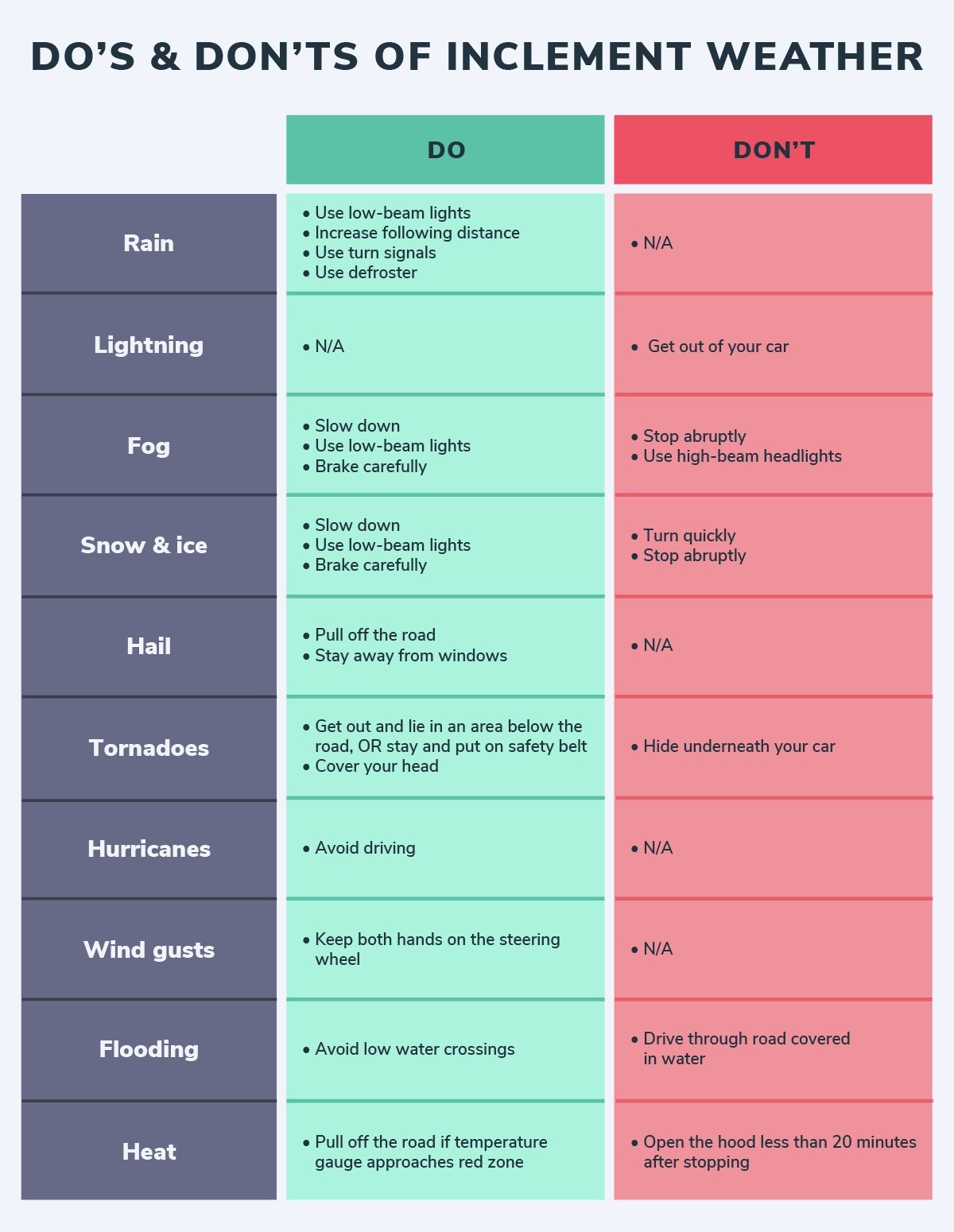Driving during severe weather is scary, but there are some things you can do to up your chances of getting where you’re going safely.
Don’t Drive in Severe Weather
Severe weather alerts aren’t just background noise—they’re often the first line of defense against dangerous driving conditions. Thanks to advances in meteorological technology, we usually get ample warning before hazards like thunderstorms, hail, tornadoes, or flash floods strike.
While you may not always have the option to delay travel, if you do, use that warning wisely. When conditions are severe, the safest move is often the simplest: stay off the roads.
Driving Through Heavy Rain
Driving through heavy rain is dangerous for several reasons: visibility is low, the road is slippery, and the drivers around you might not know how to drive safely in those conditions.
According to the CDC, if you find yourself driving in heavy rain, make sure your lights are on, slow way down, and leave plenty of following distance. If the rain becomes so heavy that you can’t see the cars in front of you or the road signs, put your hazards lights on and pull to the side of the road to wait for conditions to improve. Keep your hazard lights on so other drivers can see you more easily.
Driving Through a Flood
CDC data shows that more deaths happen every year due to flooding than any other thunderstorm-related hazard. Roads can flood quickly and can remain dangerously flooded even after a storm has passed.
If you see a flooded roadway, do not continue driving. Turn around and find another route. Most cars will lose control or even stall in only six inches of water, and a foot of water is enough to float most vehicles. Additionally, you can’t tell what the condition of the roadway is beneath the floodwater.
There’s a reason safety experts say, “Turn around, don’t drown.” Never attempt to drive through a flooded roadway.
If you find yourself in rising floodwaters, the National Weather Service advises that you should leave your vehicle if you can and get to higher ground before the vehicle is swept away.

Driving in Thunderstorms
Thunderstorms present a bunch of potential dangers to a driver, including high winds, heavy rain, flooding, lightning, and even hail. According to the American Safety Council, the average thunderstorm lasts just 30 minutes. If it’s at all possible to wait for the storm to pass before driving, that’s your safest bet.
If driving through a thunderstorm can’t be avoided, here’s what they advise:
Slow down and leave extra following distance
Avoid bridges, which have a higher chance of collapsing during a thunderstorm
Keep your doors shut and windows up
Turn your lights on
If you experience hail, high enough winds to move your car or fling debris, or lose visibility, pull over and put your hazards on to wait out the storm.
Lightning
While cars can conduct electricity, a car is actually a pretty safe place to be during a lightning storm. If you can’t get inside during a lightning storm, stay in your car with the windows up and doors closed.
Even if your car is struck by lightning, it’s unlikely that you would be electrocuted, but a nearby strike can temporarily blind you, creating a dangerous driving situation. If at all possible, wait out a lightning storm at the side of the road.
Driving Through a Tornado
Driving during a tornado is incredibly dangerous. Please, if you get an alert for a tornado warning, stay inside. If you are already on the road, the American Safety Council has this advice:
Don’t try to outrun a tornado. The funnel clouds are unpredictable and can form and reform seemingly at random. Tornadoes do not follow a straight line.
Don’t keep driving. If you can see a funnel cloud, you need to get off the road. Even an F1 tornado, the weakest classification, has winds strong enough to flip a car that is in motion.
Get out of your car and find shelter. Unlike with a thunderstorm, a vehicle is not a good place to shelter during a tornado. The winds can pick up a vehicle and flip it with you inside. If there is any way to get indoors, go indoors, preferably in a place with no windows. If not, the Safety Council advises that you find a ditch or other low area and lie on the ground, covering your head with your hands. If possible, stay away from trees or other objects that could be flung at you.
Don’t shelter under a bridge or in a tunnel. Because bridges and tunnels don’t have walls, they are actually more dangerous during a tornado than no shelter at all.
Driving in Inclement Weather

Quick Decisions, Safer Outcomes
Severe weather can develop rapidly, often leaving little time to react. By staying informed and making cautious choices—like waiting out storms or rerouting around flooded roads—you greatly reduce the risk to yourself and others. When conditions are uncertain, safety should always take priority.







